- 5 Things to Know Before Starting Your Next Project
- 1. If you have a new school construction project, it will require a solar PV system.
- 2. California Code offers two ways to calculate PV system requirements.
- 3. School projects that require a solar PV system also require a battery storage system.
- 4. Compliance is mandatory, but schools have options.
- 5. Early planning is the most cost-effective approach to compliance.
- AMS Makes Compliance Easy
Title 24: What the Solar Mandate Means for Your New School Construction Project
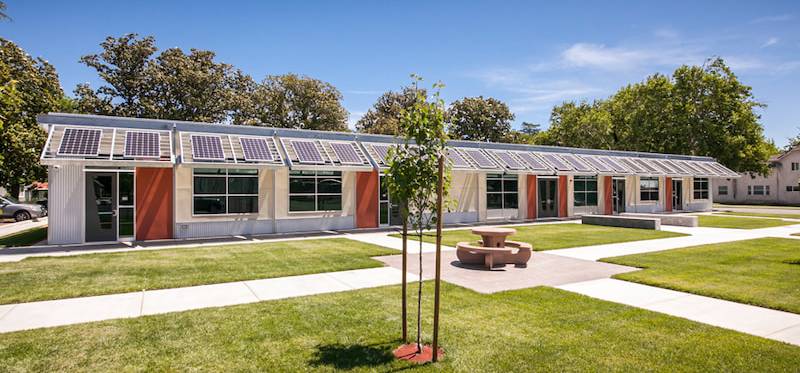
California’s clean energy goals are fast-tracking schools toward solar power. How will the updated Energy Code requirements impact your projects? Here are 5 things you need to know—plus a handy guide for finding the most cost-effective path to compliance.
This is the first of our two-part blog series on integrating solar PV and battery energy storage systems in new school buildings. Read Part 2: Q&A with Hans Marsman: Beyond Code Compliance—Saving Money and Energy with Performance-Based Design here.
The impact of a changing climate has been felt in every part of California, profoundly affecting the environment, as well as the health and well-being of all Californians. That impact is accelerating, creating a need for more resilient buildings that reduce energy usage and lower greenhouse gas emissions—buildings that reflect California’s pivot toward clean energy as a better path forward.
The California Energy Commission (CEC) has been incorporating stricter code requirements for all building types, stair-stepping critical progress toward the state’s goal of achieving 100% carbon neutrality by 2045. The 2019 Title 24 Energy Code increased the standards for energy efficiency, requiring solar photovoltaic (PV) systems for new residential low-rise buildings.
The 2022 code updated the PV requirement to include high-rise residential buildings as well as most nonresidential buildings, including schools. It also includes a prescriptive battery requirement for most new buildings.
While some California school districts have been moving toward renewable energy, effective January 1, 2023, it’s the law. The solar power progressive districts envisioned is now a mandate for all.
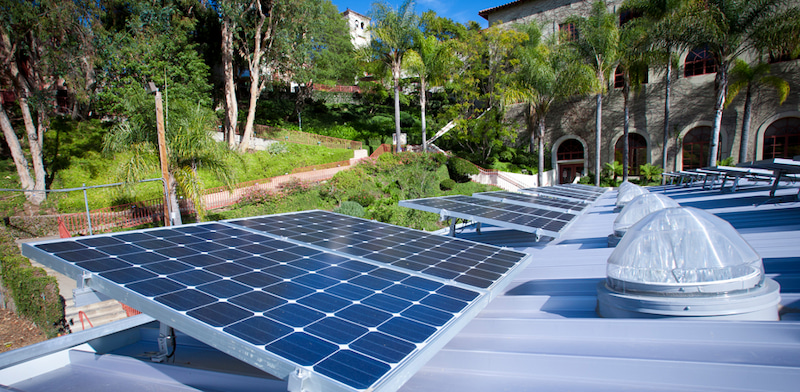
5 Things to Know Before Starting Your Next Project
The new solar PV mandate places a greater responsibility on schools, significantly impacting project design, budgeting and approval. If you’re planning—or will be planning—a school facilities project, here are 5 things you need to know.
If you have a new school construction project, it will require a solar PV system.
The 2022 Building Energy Efficiency Standards includes schools in the list of non-residential categories subject to the solar mandate. This affects the construction of new educational facilities at all levels, from preschool to community colleges. It includes classroom buildings, as well as libraries, auditoriums, gymnasiums, cafeterias, student health centers and other special use buildings on school campuses.
If you’re planning a new school facilities project anywhere in California, your project must comply with new code requirements for solar PV and battery storage systems, with three exceptions:
- Additions to existing buildings
- Alterations to existing buildings
- Unconditioned buildings
California Code offers two ways to calculate PV system requirements.
Your new school construction project requires a solar PV system, but how large a system will it need?
The solar PV requirements for schools are predefined in Section 140.10(a) of the Building Energy Efficiency Standards. System sizes are based on power capacity, measured in kilowatts (kW).
There are two ways to calculate the required system size: Conditioned Floor Area (CFA) or Solar Access Roof Area (SARA). Schools can calculate solar PV sizing using both equations and select the method that results in the lowest required annual output.
EQUATION 1: CFA (Conditioned Floor Area)
The CFA method is based on a building’s total number of square feet (ft²) of conditioned space, factored by building type and climate zone.
For school buildings, solar PV capacity is calculated using a basic kilowatts per square foot (W/ft²) ratio.
Using the CFA equation:
Solar PV Size (in kW) = Total CFA x Power Capacity A/1000
Because California’s climate is so diverse and varies widely from region to region, Power Capacity A is adjusted for a school’s specific climate zone to ensure adequate solar output year-round.

Source: 2022 California Building Energy Efficiency Standards Table 140.10-A
Based on CFA, schools in most California climate zones will need to install a solar PV system with a minimum PV capacity of 1.63 kilowatts per square foot. Schools in the milder coastal and mountain regions will require slightly smaller systems, while schools in the hot, arid desert areas of Zone 15 will require larger systems.
EQUATION 2: SARA (Solar Access Roof Area)
The second method is based on the Solar Access Roof Area, known as SARA. SARA includes a building’s unoccupied roof area capable of structurally supporting a solar PV system, as well as the roof areas of
all covered parking areas, carports and other newly constructed structures that are able to support a solar PV system. SARA does not include roof areas that are occupied or have less than 70% solar access.
Using the SARA equation:
Solar PV Size (in kW) = Total SARA x 14 W/ft²
Unlike CFA, the SARA calculation is not factored by building type or climate zone.
CFA vs. SARA: WHICH CALCULATION IS RIGHT FOR YOUR PROJECT?
A new school building’s solar PV system size should not be less than the smaller of the CFA equation factored by the appropriate climate zone or the total of all available Solar Access Roof Areas multiplied by 14 W/ft².
For most school buildings up to four stories, the CFA calculation will be smaller, so the minimum solar PV capacity required will be based on the building’s conditioned floor area. A SARA calculation is infrequently used for schools.
School projects that require a solar PV system also require a battery storage system.
New school buildings must also integrate battery energy storage systems that work in tandem with solar PV to efficiently provide and save energy. Battery storage ensures that fluctuating power demands are met, allowing a school’s PV system to provide solar power when the sun is shining, then storing solar energy for use at night or during periods when sunlight is insufficient to meet a school’s power needs.
The amount of battery storage required is prescribed by Section 140.10(b) of the updated Energy Code, based on a school’s solar PV system size. Because the two systems are interconnected, a storage-to-PV ratio determines minimum battery storage needs, factored by energy capacity and power capacity:
- Energy Capacity is the total amount of energy used during one cycle, measured in kilowatt hours (kWh or Wh).
- Power Capacity is the most power used at one time during a single cycle (peak demand), measured in kilowatts (kW or W).
The prescribed size of a school’s battery storage system considers both ratios, requiring a minimum of 1.87 kilowatt hours for each kilowatt of required PV and 0.46 kilowatts per kilowatt of required PV.
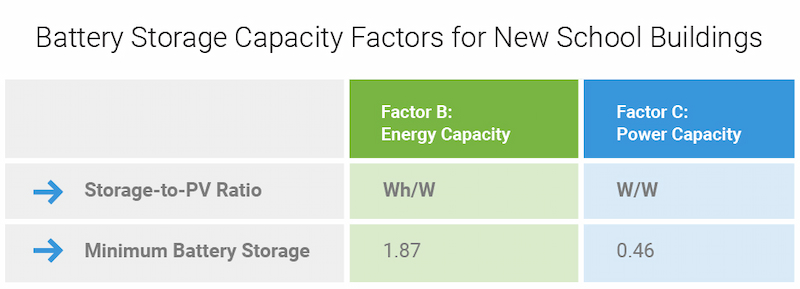
Source: 2022 California Energy Code, Table 140.10-B
Schools must consider physical space as well as system size when determining battery storage needs. Batteries need dedicated floor space and perform most efficiently in a conditioned area, where spill containment and cooling can be controlled. Ensuring adequate floor space and placement affects building design and must be addressed in planning to maintain system performance.
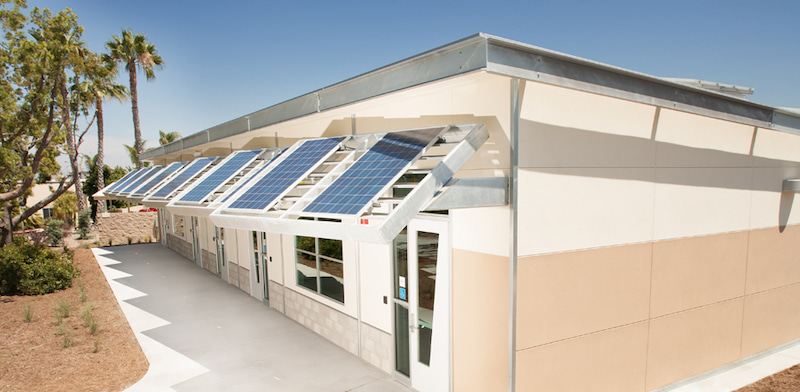
Compliance is mandatory, but schools have options.
Solar PV and battery storage systems are prescriptive requirements, but school districts can opt to use an alternate method based on building performance.
PRESCRIPTIVE METHOD
Title 24 provides a clear list of energy requirements, and a district’s project team can simply follow what the code prescribes. The Prescriptive Method is a straightforward approach that complies with California’s energy efficiency standards, reducing energy consumption, lowering emissions and creating more sustainable schools.
PERFORMANCE METHOD
Title 24 also offers a compliance path based on energy performance. The Performance Method uses energy modeling to calculate energy usage and ensure that a building will perform at or above code minimums. While code is the baseline, districts can explore different energy strategies and trade off prescriptive battery or PV requirements with building efficiency to achieve more ambitious energy goals.
PRESCRIPTIVE VS. PERFORMANCE: WHICH METHOD IS BEST FOR YOUR PROJECT?
The short answer is: the method that most closely aligns with your project goals.
While performance-based design is generally the more sustainable choice, there are pros and cons to each method and opting for one over the other is best determined by each project’s priorities and parameters.
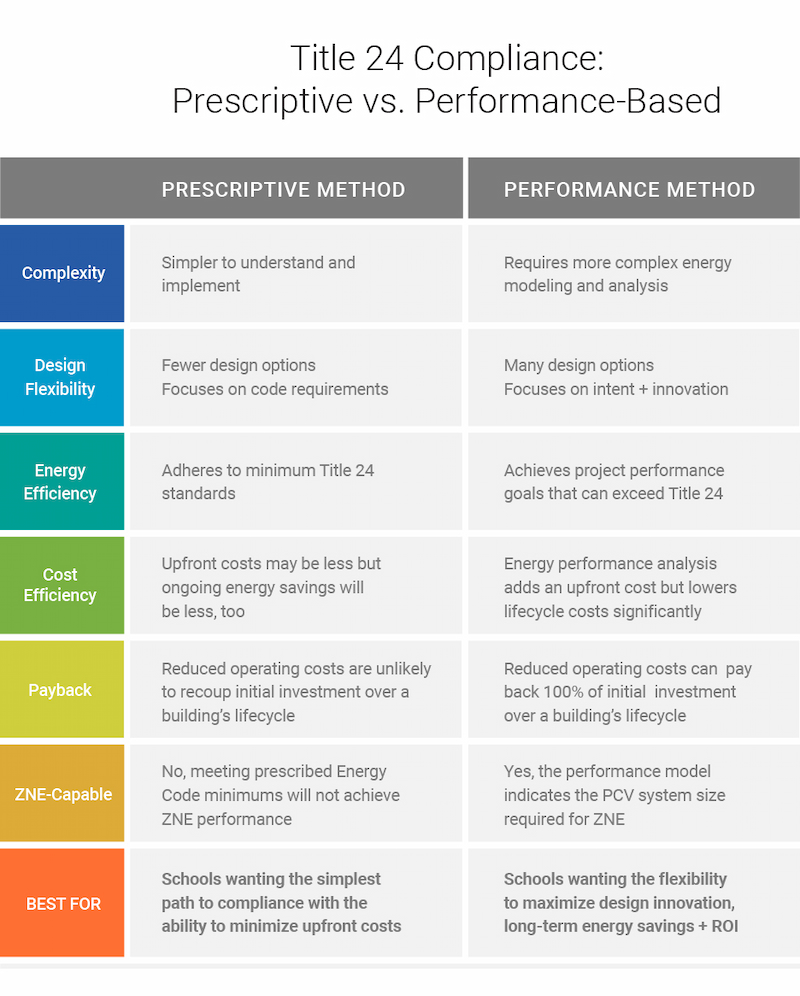
Early planning is the most cost-effective approach to compliance.
It’s important to remember that the Energy Code defines minimum requirements. The best building solution may be to increase solar capacity beyond code requirements to create a building that performs at a higher level.
A higher performance building can be more cost-effective, reducing a district’s operating budget to free up funds for other programming and activities.
A district’s sustainability plan may benchmark beyond the Title 24 minimum. A district may want to become energy independent or sell power back to the grid.
Some communities envision a more innovative building. Many districts want to explore a variety of energy strategies or need greater flexibility to meet community and stakeholder expectations.
Early planning helps districts chart the best energy path for their projects, balancing the state’s requirements with a community’s needs. Taking time to assess needs, define priorities, set goals and explore options helps districts find the most cost-effective way to create code-compliant buildings that align with individual project goals.

AMS Makes Compliance Easy
AMS has spent decades researching and developing sustainable solutions that can meet any energy target. Experience has taught us that customized solutions pay the greatest dividends—in energy and cost savings, building performance and design innovation.
That’s why we use performance-based design to ensure that all AMS buildings meet or exceed Title 24 requirements as affordably and expediently as possible while staying true to the project vision. It’s all part of creating a balanced design that considers how buildings look and feel as well as perform.

Energy modeling is complex. AMS makes it easy with an experienced team of engineers and a streamlined process that leverages the latest technology to find the best solution and create the best outcome for every project.
We recently expanded our engineering team and added a state-of-the-art engineering wing to help our clients and partners navigate the planning and design process. We’ll use our expertise to weigh efficiency options versus code requirements to create the right solar solution for your project, then value-engineer your design to maximize savings in line with your project budget and energy goals.
Code updates raised the bar, but we view it as an opportunity—to elevate, innovate and create the positive change our communities need. Higher performance schools save energy, lower costs and increase comfort, creating a healthier, more productive learning environment for today’s students and a cleaner world for future generations.
Don’t miss Part 2 of our Solar PV Blog Series!
Energy consultant Hans Marsman offers advice and guidance on integrating solar PV and battery storage systems—plus tips on using energy modeling to increase savings and building innovation with performance-based design.
Q&A with Hans Marsman:
Beyond Code Compliance—Saving Money and Energy with Performance-Based Design. Read now.
AMS high-performance buildings exceed Title 24 in all California climate zones. Find out how!